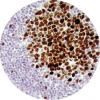Immunohistochemistry Catalog
Mouse Monoclonal Anti-
Cytokeratin (HMW)
Clone: AE3
Cat#: 10126
This antibody recognizes most of the basic (Type II) keratins. It recognizes keratin polypeptides of 58 and 65 to 67 kDa. In keratinized epidermis, 58 kDa keratin is present in the basal and suprabasal layers,
while 65 to 67 kDa keratin are expressed by cells from upper layers. This antibody can be used to stain different cell layers in an epithelial tissue and various neoplasms of epithelial origin.
Cytokeratin (LMW)
Clone: AE1
Cat#: 10128
AE1 recognizes cytokeratins 10, 14, 15, 16, and 19 in the acidic subfamily.
Cytokeratin (pan)
Clone: KL1
Cat#: 10042
This monoclonal antibody reacts on normal and neoplastic cells of epithelial origin, it does not react on epidermal basal layer cells. Specificity: Cytokeratins 1, 2, 5, 6, 7, 8, 10, 11, 14, 16, 17, 18 and 19.
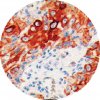
Fixed-embedded human lung cancer
Cytokeratin 5
Clone: XM26
Cat#: 10083
CK5 is an intermediate filament protein. Basal cells of epidermis express acidic CK14 and basic CK5. CK5 is a 58 kDa protein, which is closely related to CK6. XM26 can be useful in distinction of mesotheliomas from adenocarcinomas.
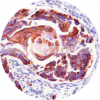
Fixed-embedded human lung squamous carcinoma
DOG1
Clone: DOG1.1
Cat#: 10119
DOG1 is expressed ubiquitously in gastrointestinal stromal tumors (GIST) irrespective of kit or PDGFR alpha mutation status. Reactivity for DOG1 may aid in the diagnosis of GISTs, including PDGFRA mutants that fail to express KIT antigen, and lead to appropriate treatment with imatinib mesylate, an inhibitor of the KIT tyrosine kinase.
E-Cadherin
Clone: ECH-6
Cat#: 10072
E-Cadherin is a calcium dependent cell adhesion molecule, expressed predominantly in epithelial tissues. E-Cadherin has important role in growth and development of cells via the mechanisms of control of tissue architecture and maintenance of tissue integrity. Reduction and/or loss of E-Cadherin expression in carcinomas correlates positively with the potential of these tumors for invasion and metastasis.
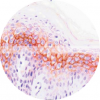
Fixed-embedded human skin
EpCAM
Clone: MOC-31
Cat#: 10129
This antibody reacts with a transmembrane glycoprotein present on most normal and malignant epithelia. Mesothelial cell derived tumors are negative.
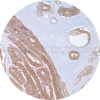
Fixed-embedded tissue
GFAP
Clone: GA-5
Cat#: 10130
Glial Fibrillary Acidic Protein (GFAP) is specific to astrocytes (i.e., glial cells) and ependymal cells of the central nervous system. This antibody is useful in differentiating prima ry gliomas from metastatic lesions in the brain and for documenting astrocytic differentiation in tumors outside the CNS.
Glucocorticoid Receptor (GCR)
Clone: 3D5
Cat#: 10023
The 3D5 monoclonal antibody labels the cytoplasm and surface membrane of GCR producing cells in bone marrow, liver and other tissues.

Fixed-embedded human breast cancer
Human Chorionic Gonadotropin β (hCG β)
Clone: 5H4E2
Cat#: 10022
5H4E2 labels the cytoplasm of HCG B producing cells in placenta, mola hydatidosa, choriocarcinoma, embryonal carcinoma seminoma and some undifferenciated lung cancers. It does not react with cells of normal endometrial, testicular tissues and lung.

Fixed-embedded human seminoma
Insulin
Clone: E2E3
Cat#: 10024
The antibody recognizes the biologically most active forms of insulin on the C-terminal end. The antibody labels the cytoplasm of B cells in pancreatic islets and insulomas, and suitable for insulin monitoring in sera from patients with diabetes or insulin producing tumors.
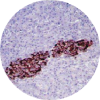
Fixed-embedded human pancreas
Lambda light chain
Clone: LcN-2
Cat#: 10131
Lambda light chains are polypeptide chains located in the cell membrane and cytoplasmic regions of normal B cells and plasma cells.
This antibody is reportedly useful in identification of leukemias, plasmacytomas, and other B cell non- Hodgkin's lymphomas.

Fixed-embedded human tonsil
Melan A (MART1)
Clone: M2-9E3
Cat#: 10133
Melan A is a melanocyte differentiation antigen. It is present in melanocytes of normal skin and retina, nevi and in more than 85% of melanomas. Very useful in establishing the diagnosis of metastatic melanomas.
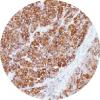
Fixed-embedded human melanoma
mGluR1
Clone: 3/G11
Cat#: 10033
3/G11 reacts on mGluR protein, which is present in brain, heart, kidneys and also in melanomas from mutant mouse melanocytes. Two types of glutamate receptors exist: ionotropic, and metabotropic receptors. Metabotropic receptors are G-protein coupled receptors, which can activate phospholipases or adenylyf -cyclases, depending on the neuron.
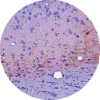
Fixed-embedded rat brain
MLH1
Clone: G168-728
Cat#: 10070
MLH1 is a mismatch repair gene that is deficient in a high proportion of patients with microsatellite instability (MSI-H). This finding is associated with the autosomal dominant condition known as Hereditary Non-Polyposis Colon Cancer (HNPCC). The anti-MLH1 antibody is useful in screening patients and families for this condition. Colon cancers that are microsatellite unstable have a better prognosis than their microsatellite stable counterparts.

Fixed-embedded human colon cancer
MSH2
Clone: 25D12
Cat#: 10071
MSH2 protein is involved in the initial recognition of mismatched nucleotides during the post replication mismatch repair process. Loss of MSH2 function leads to the accumulation of replication errors, which in turn may be responsible for the multiple mutations required for multistage carcinogenesis.
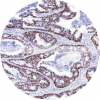
Fixed-embedded human colon cancer


